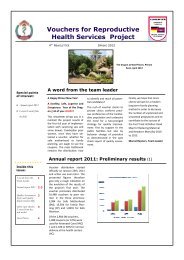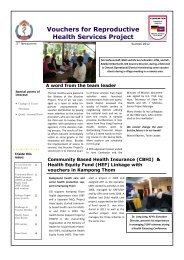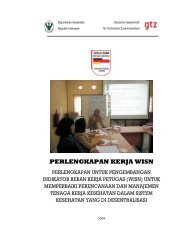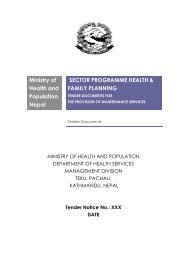The politics of public-private health partnerships - Epos
The politics of public-private health partnerships - Epos
The politics of public-private health partnerships - Epos
Create successful ePaper yourself
Turn your PDF publications into a flip-book with our unique Google optimized e-Paper software.
Development, 2004, 47(2), (49–56)<br />
r 2004 Society for International Development 1011-6370/04<br />
www.sidint.org/development<br />
Power to the Partners?: <strong>The</strong> <strong>politics</strong> <strong>of</strong><br />
<strong>public</strong>-<strong>private</strong> <strong>health</strong> <strong>partnerships</strong><br />
KENT BUSE AND<br />
ANDREW HARMER<br />
<strong>The</strong>matic Section<br />
ABSTRACT Ken Buse and Andrew Harmer review the political<br />
dimensions <strong>of</strong> global <strong>public</strong>–<strong>private</strong> <strong>health</strong> <strong>partnerships</strong> through the<br />
‘three faces <strong>of</strong> power’ lens. <strong>The</strong>y attempt to answer the questions:<br />
who has power; how is power exercised; and on what basis?<br />
Evidence, although scant, suggests that a northern elite wields<br />
power through its domination <strong>of</strong> governing bodies and also through<br />
a discourse which inhibits critical analysis <strong>of</strong> partnership while<br />
imbuing partnership with legitimacy and authority.<br />
KEYWORDS global <strong>health</strong>; elitism; pluralism; governance;<br />
membership<br />
All <strong>politics</strong> is about power.<strong>The</strong> practice <strong>of</strong> <strong>politics</strong> is <strong>of</strong>ten portrayed as little more than the exercise<br />
<strong>of</strong> power, and the academic subject as, in essence, the study <strong>of</strong> power.Without doubt, students<br />
<strong>of</strong> <strong>politics</strong> are students <strong>of</strong> power: they seek to know who has it, how it is used and on<br />
what basis it is exercised (Heywood,1999:122).<br />
Introduction<br />
Public^<strong>private</strong> <strong>partnerships</strong> (PPP) have become a prominent feature <strong>of</strong> our global<br />
<strong>health</strong> landscape in the past decade. As Figure1illustrates the number <strong>of</strong> global <strong>health</strong><br />
PPPs has steadily increased since1982; reaching a high-point in 2000 with17 new <strong>partnerships</strong>.<br />
1 Since 2000, the flurry <strong>of</strong> partnership launches has subsided, providing<br />
breathing space to reflect upon the political implications <strong>of</strong> this important mechanism<br />
<strong>of</strong> global governance.<br />
In looking at the <strong>politics</strong> <strong>of</strong> PPPs in <strong>health</strong> we see how PPPs have introduced new actors<br />
into, and generated additional resources for, the international <strong>health</strong> arena. In<br />
doing so, PPPs have altered the relative distribution <strong>of</strong> power among organizations, between<br />
<strong>public</strong> and <strong>private</strong> sectors, and between the global North and South. PPPs have<br />
changed the policies and practices <strong>of</strong> <strong>public</strong> sector organizations, such as those <strong>of</strong> the<br />
World Health Organization (WHO), which has given rise to considerable debate and<br />
controversy (Buse and Waxman, 2001). Concerns have been raised as to whether or not<br />
such <strong>partnerships</strong> are desirable; the circumstances under which <strong>partnerships</strong> should<br />
be employed; the manner in which criteria for the selection <strong>of</strong> appropriate activities,<br />
companies and industries should be established; the best ways to structure and monitor<br />
interactions between sectors so as to avoid real and perceived conflict <strong>of</strong> interest; how<br />
Development (2004) 47(2), 49–56. doi:10.1057/palgrave.development.1100029
Development 47(2): <strong>The</strong>matic Section<br />
50<br />
17<br />
16<br />
15<br />
14<br />
13<br />
12<br />
11<br />
10<br />
9<br />
8<br />
7<br />
6<br />
5<br />
4<br />
3<br />
2<br />
1<br />
7<br />
4<br />
7<br />
5<br />
7<br />
6<br />
7<br />
7<br />
to coordinate the proliferation <strong>of</strong> initiatives at the<br />
global and national level; and how to integrate<br />
them into national <strong>health</strong> systems (Buse andWalt,<br />
2000a, b; Richter, 2003).<br />
Partnership has also created new opportunities<br />
for the <strong>private</strong> sector to exercise power and influence<br />
over domains which were once the preserve<br />
<strong>of</strong> <strong>public</strong>-sector organizations, for example, in establishing<br />
norms and standards in specific issueareas.<br />
In other cases, new forms <strong>of</strong> global <strong>health</strong><br />
governance are emerging, for example in the Global<br />
Fund for AIDS, malaria and tuberculosis,<br />
wherein the commercial sector is represented,<br />
thereby pluralizing decision-making bodies and simultaneously<br />
reshaping relations <strong>of</strong> power,<br />
authority and legitimacy. In low- and middle-income<br />
countries (LMIC), where the benefits <strong>of</strong> collaboration<br />
may be most keenly felt, fears have<br />
arisen that PPPs may exhibit characteristics<br />
which might further reinforce negative elements<br />
<strong>of</strong> aid regimes, such as the distortion <strong>of</strong> domestically<br />
set priorities and policies.<br />
More positively, power may also be exercised<br />
through <strong>partnerships</strong> to encourage improved corporate<br />
social responsibility; to bring about better<br />
practices within <strong>public</strong> bureaucracies; to open-up<br />
decision-making to previously marginalized<br />
groups, such as civil society organizations; and<br />
more generally to promote good governance in international<br />
<strong>health</strong>. It is this potential for partner-<br />
7<br />
8<br />
7<br />
9<br />
8<br />
0<br />
8<br />
1<br />
Figure 1: Number <strong>of</strong> new ‘global’<strong>public</strong>^<strong>private</strong> <strong>health</strong> <strong>partnerships</strong>:1974^2003<br />
8<br />
2<br />
8<br />
3<br />
8<br />
4<br />
8<br />
5<br />
8<br />
6<br />
8<br />
7<br />
8<br />
8<br />
8<br />
9<br />
9<br />
0<br />
9<br />
1<br />
9<br />
2<br />
9<br />
3<br />
9<br />
4<br />
9<br />
5<br />
9<br />
6<br />
9<br />
7<br />
ship to transform existing relationships, to induce<br />
conflict, to upset or reinforce the status quo, that<br />
accounts for its inherently political nature. From<br />
this perspective, the political impacts <strong>of</strong> <strong>public</strong>^<br />
<strong>private</strong> partnership on the <strong>health</strong> sector are ubiquitous<br />
and may be far reaching.<br />
At the national level, urban studies and discourse<br />
analyses have begun to consider <strong>partnerships</strong><br />
in terms <strong>of</strong> power (Hastings, 1999). At the<br />
global level, however, the concept <strong>of</strong> power barely<br />
features in the PPP literature.This omission is surprising<br />
because questions <strong>of</strong> power go to the heart<br />
<strong>of</strong> much that is contentious about PPP: do PPPs represent<br />
just another vehicle for powerful actors<br />
to exert their influence and satisfy their own interests;<br />
do those who govern <strong>partnerships</strong> constitute<br />
an unrepresentative and unaccountable elite<br />
who set the global <strong>health</strong> agenda as they see fit;<br />
are <strong>partnerships</strong> ‘framing’ global heath discourse<br />
in such a way that they shape our thoughts about,<br />
and understanding <strong>of</strong>, global <strong>health</strong> issues and, if<br />
so, how and with what implications?<br />
Who has power?<br />
9<br />
8<br />
9<br />
9<br />
Answers to the question ‘Who wields power in<br />
<strong>partnerships</strong>?’ have already begun to polarize in<br />
the literature. Analysis <strong>of</strong> the distribution <strong>of</strong><br />
power in society traditionally makes a distinction<br />
between elitist and pluralist arguments (Walt,<br />
0<br />
0<br />
0<br />
1<br />
0<br />
2<br />
0<br />
3
Buse and Harmer: <strong>The</strong> Politics <strong>of</strong> Public-<strong>private</strong> Partnerships<br />
1994). <strong>The</strong> literature on <strong>partnerships</strong> broadly follows<br />
this division.<br />
Elitism<br />
Elitist accounts, as the name suggests, focus on<br />
the role <strong>of</strong> elites in society (King and Kendall,<br />
2004). Elitist theorists are sceptical <strong>of</strong> the depth<br />
<strong>of</strong> democracy, arguing that power is wielded by<br />
an elite core <strong>of</strong> individuals from various sectors <strong>of</strong><br />
society. Elite theory assumptions are evident in<br />
various studies critical <strong>of</strong> <strong>health</strong> <strong>public</strong>^<strong>private</strong><br />
<strong>partnerships</strong>. For example, Judith Richter argues<br />
that,<br />
High level PPP interactionsyare in fact instruments<br />
<strong>of</strong> elite governance which advance the corporate-led<br />
neoliberal restructuring <strong>of</strong> the world (Richter,<br />
2003: 8).<br />
According to Richter, and other partnership<br />
critics, corporate elites dominate <strong>partnerships</strong>,<br />
and will inevitably subvert the <strong>public</strong> service <strong>of</strong> international<br />
organizations such as the UN or the<br />
WHO (Karliner,1999; Utting, 2001; Richter, 2003).<br />
Through partnership with the commercial<br />
sector, ‘the UN and its agencies have let loose a<br />
force over which they now have little control’<br />
(Richter, 2003:7). For Richter, the solution is clear:<br />
UN agencies should abandon the <strong>public</strong>^<strong>private</strong><br />
partnership paradigm altogether.<br />
Pluralism<br />
In response, pluralist accounts note the diverse<br />
range <strong>of</strong> (overlapping) interest groups seeking influence<br />
in <strong>partnerships</strong>, but contend that <strong>partnerships</strong><br />
are neutral arrangements that do not<br />
defend the interests <strong>of</strong> any one particular actor or<br />
group. For pluralists, power is shared, no one partner<br />
dominates, and decisions are made through<br />
consensus (Held, 1996; Walt, 1994). Pluralists regard<br />
elitist criticism as exaggerated. In a recent<br />
editorial, for example, RoyWiddus argues that,<br />
To include one person representing the pharmaceutical<br />
industry in the 16-member Board <strong>of</strong> GAVI (the<br />
Global Alliance for Vaccines and Immunization) is<br />
unlikely to overturn the entire policy-making sys-<br />
tems <strong>of</strong> WHO, UNICEF, the World Bank and the other<br />
members (Widdus, 2003: 235).<br />
Corporate elite influence appears even more<br />
unlikely when one considers that the host <strong>of</strong> the<br />
GAVI secretariat (UNICEF) retains the right to<br />
veto, and each partner can ignore the Board’s decisions<br />
(ibid).<br />
Neo-pluralism<br />
In -between these two positions lie studies <strong>of</strong> <strong>partnerships</strong><br />
that may be more accurately described<br />
as neo-pluralist. Neo-pluralism acknowledges<br />
that multiple pressure groups operate within society,<br />
but argue that the agenda is, or is in danger<br />
<strong>of</strong> becoming, biased towards specific individuals<br />
and groups, <strong>of</strong>ten corporate players (Held, 1996).<br />
<strong>The</strong>se studies remain open to the potential <strong>of</strong> <strong>partnerships</strong><br />
but highlight the risks involved, and suggest<br />
possible ways <strong>of</strong> structuring <strong>public</strong>^<strong>private</strong><br />
interaction so that it becomes more accountable<br />
and equitable, and less risky (Buse and Walt,<br />
2000a, b).<br />
<strong>The</strong> discursive construction <strong>of</strong> PPPs<br />
<strong>The</strong> concept <strong>of</strong> partnership is constructed through<br />
a dominant discourse as ‘natural’, inevitable, and<br />
as ‘win^win.’ Partnerships are, therefore, considered<br />
desirable solutions to global <strong>health</strong> crises. Similarly,<br />
any negative impacts or consequences<br />
are regarded as regrettable but unavoidable: for<br />
example, the challenges <strong>of</strong> coordinating a proliferation<br />
<strong>of</strong> initiatives, or the burden placed on recipient<br />
administrations in terms <strong>of</strong> applications,<br />
monitoring and reporting. <strong>The</strong> discursive construction<br />
<strong>of</strong> ‘partnership’ has been so effective that<br />
criticism <strong>of</strong> partnership per se is almost unthinkable.<br />
Alternative modes <strong>of</strong> thinking about <strong>partnerships</strong><br />
are, however, beginning to emerge.<br />
Richter’s analysis, for example, suggests replacing<br />
the phrase <strong>public</strong>^<strong>private</strong> partnership with <strong>public</strong>^<strong>private</strong><br />
interaction: the point being that language<br />
is not neutral, and the term ‘partnership’<br />
disguises unequal power relations between <strong>public</strong><br />
institutions and <strong>private</strong> industry, or indeed between<br />
civil society and the <strong>private</strong> sector or be-<br />
51
Development 47(2): <strong>The</strong>matic Section<br />
52<br />
tween North and South. In addition, innovative<br />
new <strong>partnerships</strong> such as the Drugs for Neglected<br />
Diseases Initiative (DNDi), are beginning to distance<br />
themselves from terms such as <strong>public</strong>^<strong>private</strong><br />
to describe their interaction with <strong>private</strong><br />
sector actors. DNDi is happy to be called a partnership,<br />
but its staff emphasize that no <strong>private</strong>-sector<br />
representative sits on its Board <strong>of</strong> governors.<br />
It may be helpful to provide a more rigorous<br />
conceptual framework for understanding the discourse<br />
<strong>of</strong> <strong>partnerships</strong>. Constructivist analysis is<br />
rarely employed by international <strong>health</strong> scholars<br />
(Kickbusch and Buse, 2000; Kickbusch, 2003),<br />
but it can be usefully applied in this context. Klotz,<br />
for example, argues that constructivists ‘seek to<br />
understand how certain ideas get taken for<br />
granted or dominate while others remain unspoken<br />
or marginalized’. Thus, constructivism should<br />
have something <strong>of</strong> value to add to the partnership<br />
debate by suggesting ways <strong>of</strong> reconceptualizing<br />
and questioning assumptions underpinning the<br />
idea <strong>of</strong> partnership. One way forward would be to<br />
apply the formulation provided by Ian Hacking in<br />
his book ‘<strong>The</strong> Social Construction <strong>of</strong> What?’<br />
(Hacking,1999). Hacking’s formulation is provided<br />
in Box1.<br />
What Hacking’s account serves to emphasize,<br />
argues Hay,‘is the stress placed by constructivists<br />
upon the contingent or open-ended nature <strong>of</strong> social<br />
and political processes and dynamics ^ especially<br />
those conventionally seen as fixed’ (Hay,<br />
2002: 201). Hacking’s framework includes a clear<br />
normative component. However, it is possible to<br />
sound a cautionary note without dismissing PPP<br />
completely. In particular, a constructivist ap-<br />
Box 1. Hacking’s constructivist framework<br />
In the present states <strong>of</strong> affairs, X is taken for<br />
granted.<br />
X need not have existed, or need not be as<br />
it is. X, or X as it is at present, is not<br />
determined by the nature <strong>of</strong> things; it is<br />
not inevitable.<br />
X is quite bad as it is.<br />
We would be much better <strong>of</strong>f if X were<br />
done away with, or at least radically<br />
transformed.<br />
proach invites us to reflect upon PPP as a governance<br />
response to global <strong>health</strong> crises, and in<br />
particular to question whether or not it has been<br />
adequately compared to alternative global <strong>health</strong><br />
strategies. In addition, it would expose many assumptions<br />
which are being made about PPP ^ including<br />
the absence <strong>of</strong> alternative strategies; that<br />
they are ‘win^win^win’ mechanisms <strong>of</strong> global<br />
governance; that they provide value-for-money in<br />
relation to <strong>public</strong> expenditure ^ which are not<br />
only unsubstantiated, but which are presented as<br />
justification for their continued use. Consequently,<br />
as Box 2 illustrates, the Hacking framework<br />
can be recast to raise questions about PPP.<br />
In the context <strong>of</strong> PPP, Hacking’s formulation ^<br />
where X is <strong>public</strong>^<strong>private</strong> partnership ^ presents<br />
an alternative and exciting research strategy. Focusing<br />
attention on the interactions inherent in<br />
the relationship (rather than on an ill-defined<br />
and increasingly value-laden term such as ‘partnership’)<br />
reveals the opportunities, costs and risks<br />
<strong>of</strong> collaboration, and provides an alternative discourse<br />
which may lead to altogether different outcomes<br />
as far as collaboration is concerned.<br />
On what basis is power exercised?<br />
In <strong>partnerships</strong>, power may be exercised on the<br />
basis <strong>of</strong> coercion, either political or financial, but<br />
also on the basis <strong>of</strong> authority and legitimacy. In<br />
its broadest sense, authority is a form <strong>of</strong> power,<br />
although the two concepts are clearly distinct.<br />
Authority exists when a PPP has decision-making<br />
power over a particular issue-area and is regarded<br />
as exercising that power legitimately (Cutler et al.,<br />
1999). In the area <strong>of</strong> neglected diseases, for exam-<br />
Box 2. PPP constructivist framework<br />
In the present state <strong>of</strong> affairs, PPP is assumed.<br />
PPP need not be as it is. <strong>The</strong>re are alternatives<br />
to PPP. PPP is not inevitable.<br />
Alternatives to PPPs should be explored,<br />
and comparisons made, because PPPs<br />
involve significant risks as well as benefits.<br />
PPP should take into account, as a priority,<br />
these risks.
Buse and Harmer: <strong>The</strong> Politics <strong>of</strong> Public-<strong>private</strong> Partnerships<br />
ple, market and <strong>public</strong>-sector failure has meant<br />
that no drugs at all are being developed for conditions<br />
such as leishmaniasis, sleeping sickness and<br />
Chagas (M.S.F., 2001). On the one hand, the <strong>public</strong><br />
sector lacks expertise and access to pharmaceutical<br />
industries’ libraries <strong>of</strong> drug compounds. On<br />
the other hand, neglected diseases are not perceived<br />
to be pr<strong>of</strong>it-making investments. Through<br />
partnership with pharmaceutical companies,<br />
PPPs such as theTB Alliance and DNDi are raising<br />
the pr<strong>of</strong>ile <strong>of</strong> neglected diseases, setting the agenda<br />
for global <strong>health</strong> interventions to resolve this<br />
crisis in R&D, and making targeted investments<br />
to catalyse drug discovery and development. <strong>The</strong><br />
18 GPPPH study mentioned above found that half<br />
<strong>of</strong> the sample reports the development <strong>of</strong> technical<br />
norms and standards among their activities (Buse,<br />
2003). PPPs, therefore, enjoy an increasing degree<br />
<strong>of</strong> authority over areas <strong>of</strong> the global <strong>health</strong> sector.<br />
Authority and, ultimately, power, requires legitimacy.<br />
Legitimacy is usually positioned between<br />
power and authority: it is ‘the quality that<br />
transforms naked power into rightful authority’<br />
(Heywood, 1999:141). PPPs have legitimacy to the<br />
extent that they are democratic, representative,<br />
and transparent (Borzel and Risse, 2003). PPPs<br />
gain legitimacy by providing a good or a welfareenhancing<br />
intervention (output), and by reflecting<br />
the wishes and resources <strong>of</strong> those for whom<br />
the partnership is set up to help (input). <strong>The</strong> legitimacy<br />
<strong>of</strong> PPPs remains highly contentious, particularly<br />
in respect <strong>of</strong> <strong>private</strong>-sector involvement.<br />
Bruhl, for example, argues that:<br />
<strong>The</strong> inclusion <strong>of</strong> <strong>private</strong> actors, both for-pr<strong>of</strong>it and<br />
not-for-pr<strong>of</strong>it, enhances the problems <strong>of</strong> democratic<br />
legitimacy in international institutions rather than<br />
help to alleviate them since <strong>private</strong> actors contribute<br />
to the ‘de-governmentalization’ and ‘commercialization’<strong>of</strong><br />
world <strong>politics</strong> (Bruhl, 2001).<br />
While the authority and legitimacy <strong>of</strong> PPPs may<br />
be contested, it is readily apparent that these two<br />
attributes endow PPPs with power for global<br />
<strong>health</strong> governance.<br />
Illustrations <strong>of</strong> power being exercised in/<br />
through PPPs<br />
<strong>The</strong> manner in which power operates within<br />
<strong>partnerships</strong> has been subject to very little analy-<br />
sis. Three issues are discussed below to serve as<br />
illustrative examples <strong>of</strong> the emerging trends, as<br />
well as to provide entry points for further research.<br />
<strong>The</strong>se relate to hosting arrangements,<br />
Board compositions, and membership criteria.<br />
Hosting arrangements<br />
Hosting arrangements may effect the distribution<br />
and exercise <strong>of</strong> power within <strong>partnerships</strong> (Buse,<br />
2004). Partnerships may be differentiated on the<br />
basis <strong>of</strong> whether they are ‘hosted’ by sponsoring<br />
organization (e.g., the Global Polio Eradication Initiative<br />
(GPEI) which is hosted byWHO), or are legally<br />
independent entities, such as the Medicines<br />
for Malaria Venture (MMV). If <strong>partnerships</strong> are<br />
hosted, then a further distinction can be made between<br />
<strong>public</strong> organizations (e.g., GAVI hosted by<br />
UNICEF), NGOs (e.g., Children’s Vaccine Program<br />
hosted by PATH); or <strong>private</strong> sector organizations<br />
(e.g., the Viramune Donation Program hosted by<br />
Boehringer^Ingelheim).<br />
A study <strong>of</strong> a sample <strong>of</strong> 18 GPPHP (Buse, 2003)<br />
revealed that the ‘governing bodies’<strong>of</strong> many <strong>partnerships</strong><br />
hosted by NGO and multilateral organizations<br />
raise questions concerning the nature<br />
and meaning <strong>of</strong> ‘partnership’, and draw attention<br />
to the distribution <strong>of</strong> power (<strong>partnerships</strong> hosted<br />
by the commercial sector were not among the<br />
sample but are likely to raise the same issues).<br />
First, some <strong>of</strong> the <strong>partnerships</strong>, such as Coartem,<br />
the Global Alliance to Eliminate Leprosy (GAEL)<br />
and the Campaign to Eliminate Maternal and<br />
Neo-natal Tetanus (MNT) do not have governing<br />
bodies per se ^ rendering the ‘sharing <strong>of</strong> decisionmaking’<br />
problematic. Second, a number <strong>of</strong> the initiatives,<br />
such as the Mectizan and the Malarone<br />
Donation Programs, have Technical Advisory<br />
Committees, nominally considered ‘governing<br />
bodies,’which perform advisory functions but lack<br />
formal fiduciary or managerial authority. Such arrangements<br />
confer considerable power on the secretariat<br />
or host. Third, even where formal<br />
governing bodies, such as Boards, have been established,<br />
these have no legal status and <strong>of</strong>ten lack<br />
authority over the secretariat ^ the partnership<br />
secretariat and executive remain accountable up<br />
the hierarchical chain <strong>of</strong> command.<br />
53
Development 47(2): <strong>The</strong>matic Section<br />
54<br />
<strong>The</strong> first major external evaluation <strong>of</strong> a‘hosted’<br />
<strong>partnerships</strong>, that <strong>of</strong> RBM which is hosted by<br />
WHO, found that the ‘loose’governance structure<br />
has introduced inefficiencies in decision-making<br />
and has contributed towards lack <strong>of</strong> accountability<br />
with in the Partnership,’and that the‘Secretariat<br />
is seen to be more responsive to WHO than to<br />
other Partners’ (Feachem et al.,2002). It may, however,<br />
be the case that the governance structure remains<br />
ill-defined so as to mask the fact that the<br />
hosting organization does not wish to relinquish<br />
control over partnership activities. An external<br />
evaluation <strong>of</strong> the Global Stop TB Partnership (Stop<br />
TB), also hosted byWHO, found ‘a wide divergence<br />
<strong>of</strong> views on any hierarchical relationships among<br />
Partnership components and whether the Board<br />
has a directing or steering function within the<br />
partnership’. (Caines et al., 2003). This distribution<br />
<strong>of</strong> power has significance for the perception <strong>of</strong><br />
ownership <strong>of</strong> the partnership by partners and<br />
their consequent commitment to it.<br />
Representation on governing bodies<br />
Where Boards are the paramount decision-making<br />
bodies in <strong>partnerships</strong>, they provide sites <strong>of</strong><br />
power and, at times, contestation. <strong>The</strong> composition<br />
<strong>of</strong> Boards, therefore, provides some guidance<br />
in relation to who has power. Table1provides data<br />
on representation in small sample <strong>of</strong> major PPPs.<br />
Table 1. Representation on Governing Bodies <strong>of</strong> Select PPPs<br />
Partnership Governing<br />
body<br />
Meeting<br />
frequency<br />
Although the findings may not be representative,<br />
they do suggest that the <strong>private</strong> sector is not well<br />
represented in theWHO-hosted <strong>partnerships</strong> (Roll<br />
Back Malaria (RBM), Stop TB and WHO Programme<br />
to Eliminate Sleeping Sickness (WPESS))<br />
and that one <strong>of</strong> the independent <strong>partnerships</strong><br />
lacks <strong>public</strong> sector representation (i.e., International<br />
Trachoma Initiative (ITI)). What is more<br />
striking is the imbalance in representation between<br />
those working for institutions based in the<br />
global North and those in the South. Some <strong>of</strong> the<br />
<strong>partnerships</strong> have no southern representation<br />
and in only one is there an even balance. Those<br />
constituencies who are represented on the governing<br />
bodies <strong>of</strong> <strong>partnerships</strong> are likely able to<br />
wield more influence over the priorities <strong>of</strong> the<br />
partnership than those which are not.<br />
In addition, it is clear from a recent study <strong>of</strong><br />
three neglected disease PPPs Stop TB partnership,<br />
the TB Alliance, and the DNDi (Harmer, unpublished)<br />
that the ideas which informed, and ultimately<br />
shaped the <strong>partnerships</strong>, originate from a<br />
highly unrepresentative sector <strong>of</strong> the global<br />
<strong>health</strong> community. Approximately 35 actors were<br />
identified as significant in mobilizing and providing<br />
essential support during the ‘early-days’<strong>of</strong> the<br />
sample PPPs. Of these, all were from wealthy, middle-class<br />
socio-economic groupings; none were<br />
African, indeed all but one were ‘white’, and only<br />
four were female.<br />
Chair Size Composition Representation<br />
Pub For<br />
pr<strong>of</strong>it<br />
Not<br />
pr<strong>of</strong>it<br />
Non-<br />
LMIC<br />
GATBDD Board 2/year Public 11 4 4 3 10 1<br />
GAVI Board 2/year Public 11 5 2 4 8 3<br />
Working group 4/year ? 9 5 1 3 9 0<br />
IAVI Board 3/year Private 15 5 7 3 14 1<br />
ITI Board 2/year NFP 7 0 3 4 7 0<br />
MMV Board 2/year NFP 11 5 1 5 9 2<br />
RBM Board 2/year Public 17 14 1 2 9 8<br />
Stop TB Coordinating board 2/year Public 27 18 0 9 18 9<br />
WPESS Coordinating board 2/year ? 11 4 0 7 8 3<br />
LMIC
Membership<br />
Buse and Harmer: <strong>The</strong> Politics <strong>of</strong> Public-<strong>private</strong> Partnerships<br />
One <strong>of</strong> the most contested issues in relation to<br />
membership concerns whether or not to screen<br />
commercial firms for corporate social responsibility,<br />
and if so against which criteria, whether or<br />
not reporting and verification should be voluntary<br />
or mandatory and provided by independent bodies<br />
or self-reported.<br />
<strong>The</strong> debate about membership <strong>of</strong> PPPs is<br />
contested in the <strong>health</strong> and other arenas as<br />
it is fundamentally about who has the power,<br />
authority and legitimacy to establish the<br />
standards <strong>of</strong> corporate conduct. One study <strong>of</strong><br />
the policies <strong>of</strong> five multilateral organizations<br />
found significant differences <strong>of</strong> policy and practice<br />
in terms <strong>of</strong> the criteria adopted and the rigour<br />
<strong>of</strong> the process and in some <strong>of</strong> these organizations,<br />
particularly at the WHO, where major controversies<br />
exist at the level <strong>of</strong> the Board (Buse and<br />
Ouseph, 2002). A review <strong>of</strong> 18 GPPPHs revealed<br />
scant evidence that corporate partners to the<br />
PPPs were vetted for social corporate responsibility,<br />
financial integrity or against other negative<br />
or positive criteria prior to their selection. In<br />
many <strong>of</strong> these <strong>partnerships</strong>, the <strong>public</strong> sector<br />
had no alternative to the firm in question which<br />
might account for the lack <strong>of</strong> scrutiny (i.e., the corporate<br />
partner was in a monopoly position with<br />
respect to a product or service, which is the case<br />
for many <strong>of</strong> the access <strong>partnerships</strong>). While this<br />
may be the case, lack <strong>of</strong> competition in itself does<br />
not, reduce potential risks associated with partnering<br />
and consequently does not diminish the<br />
need for criteria and procedures for corporate selection.<br />
Conclusions<br />
An analysis <strong>of</strong> power within <strong>partnerships</strong> suggests<br />
that a dominant discourse has emerged constructing<br />
a paradigm <strong>of</strong> <strong>public</strong>^<strong>private</strong><br />
collaboration that may inhibit mainstream analysis<br />
<strong>of</strong> alternatives, value-for-money for <strong>public</strong> sector<br />
investments, or the potential negative<br />
externalities that may arise at the global and national<br />
levels. Critics <strong>of</strong> partnership, <strong>of</strong>ten adopting<br />
a relatively simplistic approach to power, question<br />
the assumption <strong>of</strong> equal power relations in collaborative<br />
initiatives by drawing attention instead<br />
to the interactions among organizations so as to<br />
identify potential risks and risk management strategies.<br />
A similarly skeptical approach is emerging<br />
from very different quarters. <strong>The</strong> World Bank, for<br />
example, has recognized the many risks <strong>of</strong> partnership<br />
and issued detailed guidelines to enable<br />
its staff to identify the true costs <strong>of</strong> collaboration<br />
and weigh them against the benefits to the organization<br />
and its mission (World Bank, 2001). Similarly,<br />
increasingly sophisticated approaches to<br />
risk-assessment and management are emerging<br />
in the business development teams <strong>of</strong> product development<br />
<strong>partnerships</strong> (Kettler et al., 2003).<br />
Despite their political nature, the <strong>politics</strong> <strong>of</strong><br />
<strong>partnerships</strong> have not been explicitly researched.<br />
<strong>The</strong> study <strong>of</strong> power in ‘global’ PPPs, in particular,<br />
deserves closer scrutiny. At the national level such<br />
study has begun in earnest, notably in the field <strong>of</strong><br />
discourse analysis (Hastings, 1999), but also in<br />
the sub-field <strong>of</strong> Urban Studies. Students <strong>of</strong> the latter<br />
have long been aware <strong>of</strong> the possibilities <strong>of</strong> ‘systemic<br />
power’ in regimes (Stone, 1980; Judge et al.,<br />
1995), and such analysis may usefully be applied<br />
to global PPPs.<br />
Notes<br />
1<strong>The</strong> initiative on <strong>public</strong>-<strong>private</strong> <strong>partnerships</strong> for <strong>health</strong> (IPPPH), from which the data for Figure 1is taken, has detailed<br />
information on 90 <strong>health</strong> <strong>partnerships</strong> (www.ippph.org).<br />
References<br />
Borzel,T. and T. Risse (2003) ‘Public-Private Partnerships: Effective and legitimate tools <strong>of</strong> international governance?’,<br />
in E.Grande and W.Pauly (eds.) Reconstituting Political Authority: Complex sovereignty and the foundations <strong>of</strong> global<br />
governance, Baltimore, MD: Johns Hopkins University Press.<br />
Bruhl, T. (2001) ‘<strong>The</strong> Privatisation <strong>of</strong> Governance Systems: On the legitimacy <strong>of</strong> environmental policy’, paper presented<br />
at ‘Global Environment and the Nation State’, at Berlin,7^8 December, 2001.<br />
55
Development 47(2): <strong>The</strong>matic Section<br />
56<br />
Buse, K. (2003) ‘Governing Partnership ^ A Comparative Analysis <strong>of</strong> the Organizational and Managerial Arrangements<br />
<strong>of</strong> 18 Global Public^Private Health Partnerships & A Compendium <strong>of</strong> PPP Organizational Pr<strong>of</strong>iles’. Geneva:<br />
Initiative on Public^Private Partnerships for Health.<br />
Buse, K. (2004) ‘Governing Public^Private Infectious Disease Partnerships’, Brown Journal <strong>of</strong> World Affairs 10(2):<br />
225^242.<br />
Buse, K. and G.Walt (2000a) ‘Global <strong>public</strong>^<strong>private</strong> <strong>health</strong> <strong>partnerships</strong>: Part II ^ what are the issues for global governance?’,<br />
Bulletin <strong>of</strong> theWorld Health Organization, 200078(5): 699^709.<br />
Buse, K. and G.Walt (2000b) ‘Global <strong>public</strong>^<strong>private</strong> <strong>partnerships</strong>: Part I ^ a new development in <strong>health</strong>?’, Bulletin <strong>of</strong> the<br />
World Health Organization, 200078(4):549^561.<br />
Buse, K. and A.Waxman (2001) ‘Public^Private Health Partnerships: A strategy for WHO’, Bulletin <strong>of</strong> theWorld Health<br />
Organization 79(8):748^754.<br />
Buse, K. and R. Ouseph (2002) Reaping reward ^ reducing risks. Public-<strong>private</strong> <strong>health</strong> <strong>partnerships</strong>: A comparative<br />
analysis <strong>of</strong> the policies and guidelines governing the interaction <strong>of</strong> WHO, UNAIDS, UNFPA, UNICEFand the World<br />
Bank with the commercial sector Geneva:<strong>The</strong> Initiative on Public^Private Partnerships for Health. unpublished.<br />
Caines, K. et al. (2003) Independent Evaluation <strong>of</strong> the Global StopTB Partnership, London: IHSD.<br />
Feachem, R., C. Medlin, D. Daniels, D. Dunlop, H. Mshinda and J. Petko et al. (2002) Achieving impact: Roll back malaria<br />
in the next phase Final report <strong>of</strong> the external evaluation <strong>of</strong> Roll Back Malaria Geneva:WHO.<br />
Hacking, I. (1999) <strong>The</strong> Social Construction <strong>of</strong>What?, Cambridge, MA: Harvard University Press.<br />
Hastings, A. (1999) ‘Analysing Power Relations in Partnerships: Is there a role for discourse analysis?’, Urban Studies<br />
36(1): 9^106.<br />
Heywood, A. (1999) Political<strong>The</strong>ory: An introduction second edition. NewYork: Macmillan.<br />
Kettler,H.,K.WhiteandS.Jordan(2003)Valuing Industry Contributionsto Public^Private Partnerships for Health Development,<br />
Geneva: IPPPH.<br />
Kickbusch, I. and K. Buse (2000) ‘Global influences and global responses: International <strong>health</strong> at the turn <strong>of</strong> the 21st<br />
century’, in MH Merson, RE Black, AJ Mills (eds.) International Public Health, Gaithersberg: Aspen.<br />
Kickbusch, I. (2003) ‘Global Health Governance: Some theoretical considerations on the new political space’, in K. Lee<br />
(ed.) Health Impacts <strong>of</strong> Globalization:Towards global governance,Palgrave.<br />
M.S.F. (2001) Fatal Imbalance:<strong>The</strong> crisis in R&D for drugs for neglected diseases, Geneva: Medecins Sans Frontieres.<br />
Richter, J. (2003) ‘We the Peoples’or ‘We the Corporations’? Critical reflections on UN-business ‘<strong>partnerships</strong>’, Geneva: IB-<br />
FAN.<br />
Stone, C. (1980) ‘Systemic Power in Community Decision Making: A restatement <strong>of</strong> stratification theory’,<strong>The</strong>American<br />
Political Science Review 74(4): 978^990.<br />
Utting,P.(2001)UN ^ Business Partnerships:WhoseAgenda Counts? Paper presented at a conference organized by the<br />
North^South Coalition,‘Partnerships for Development or Privatization <strong>of</strong> the Multilateral System?.<br />
Walt,G.(1994)Health Policy: An introduction to process and power, London: Zed Books.<br />
Widdus, R. (2003) ‘Public-<strong>private</strong> <strong>partnerships</strong> for <strong>health</strong> require thoughtful evaluation’, Bulletin <strong>of</strong> theWorld Health<br />
Organization, 2003 81(4): 235.<br />
World Bank (2001) Partnerships with the Private Sector: Assessment and approval,Washington DC:World Bank.















